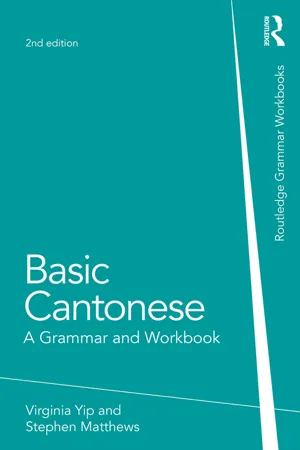
This is a test
- 176 pages
- English
- ePUB (mobile friendly)
- Available on iOS & Android
eBook - ePub
Book details
Book preview
Table of contents
Citations
About This Book
Basic Cantonese introduces the essentials of Cantonese grammar in a straightforward and systematic way.
Each of the 28 units deals with a grammatical topic and provides associated exercises, designed to put grammar into a communicative context. Special attention is paid to topics which differ from English and European language structures.
This new edition features:
• clear, accessible format
• lively examples to illustrate each grammar point
• informative keys to all exercises
• glossary of grammatical terms
Basic Cantonese is ideal for students new to the language. Together with its sister volume, Intermediate Cantonese, it forms a structured course of the essentials of Cantonese grammar.
Frequently asked questions
At the moment all of our mobile-responsive ePub books are available to download via the app. Most of our PDFs are also available to download and we're working on making the final remaining ones downloadable now. Learn more here.
Both plans give you full access to the library and all of Perlego’s features. The only differences are the price and subscription period: With the annual plan you’ll save around 30% compared to 12 months on the monthly plan.
We are an online textbook subscription service, where you can get access to an entire online library for less than the price of a single book per month. With over 1 million books across 1000+ topics, we’ve got you covered! Learn more here.
Look out for the read-aloud symbol on your next book to see if you can listen to it. The read-aloud tool reads text aloud for you, highlighting the text as it is being read. You can pause it, speed it up and slow it down. Learn more here.
Yes, you can access Basic Cantonese by Virginia Yip,Stephen Matthews in PDF and/or ePUB format, as well as other popular books in Languages & Linguistics & Languages. We have over one million books available in our catalogue for you to explore.
Information
Unit 1
Consonants
In Cantonese, it is useful to distinguish initial consonants, that is those which occur at the beginning of a syllable, from those found at the end of a syllable.
Initial consonants
| Unaspirated | Aspirated | Fricative | Nasal/liquid | |
| | ||||
| Bilabial/labiodental | b | p | f | m |
| Dental/alveolar | d | t | s | n/l |
| Velar/glottal | g | k | h | ng |
| Labiovelar | gw | kw | ||
| Alveolar affricates | j | ch | ||
The consonant sounds in the third and fourth columns – the fricatives f, s, h and the nasals m, n, ng – are pronounced much as in English, while the first two columns pose greater difficulty. Whereas English stops such as p and b are distinguished by the fact that p is voiceless and b voiced, no Cantonese stops are distinctively voiced; instead they are distinguished by aspiration – a burst of air emitted in the process of articulation. In English, this feature is also present in that initial p is normally aspirated and b not; however, this contrast is not a distinctive one. To an English speaker, Cantonese b as in béi 畀 ‘give’ may sound either like p (because of the lack of voicing) or like b (because of the lack of aspiration). This combination of features – voiceless and unaspirated – is not found in English, making the Cantonese consonants b/d/g difficult to recognize and produce at first. Remember that b- as in bāt 筆 ‘pen’, d- as in deui 對 ‘pair’ and g- as in gwai 貴 ‘expensive’ are not voiced. The problem also arises in romanized place names: Kowloon, for example, is generally pronounced by English speakers with an aspirated [k], but in the Cantonese form Gáulùhng 九 龍 the initial consonant is not aspirated.
In the labiovelar consonants gw and kw, the initial velar consonant is articulated more or less simultaneously with the bilabial [w] as in gwa 掛 ‘hang’ and kwàhn 裙 ‘skirt’. There is a tendency to simplify gw and kw to [ɡ] and [k], respectively, before o or u, e.g. gwok 國 ‘country’ sounds identical to gok 覺 ‘feel’. Similarly:
| Gwóngjāu 廣州 | → | Góngjāu Canton (Guangzhou) |
| gwú 估 | → | gú guess |
| gwun 罐 | → | gun can (of beer, Coke, etc.) |
| kwòhng 狂 | → | kòhng crazy |
The affricates j and ch are probably the most difficult of the initial consonants. They are distinguished by aspiration: ch is accompanied by a breath of air while j is not. There are two rather different pronunciations for each consonant, depending on the follo...
Table of contents
- Cover
- Title
- Copyright
- Dedication
- CONTENTS
- Preface to the second edition
- Introduction
- 1 Consonants
- 2 Vowels and diphthongs
- 3 Tone
- 4 Pronouns
- 5 Possession: ge 嘅
- 6 Possession and existence: yáuh 有
- 7 Being: haih 係
- 8 Noun classifiers
- 9 Adjectives
- 10 Adverbs of manner
- 11 Adverbs of time, frequency and duration
- 12 Comparison: gwo 過 and dī 啲
- 13 Prepositions: space and time
- 14 Negation
- 15 Verbs of motion: heui 去 and làih 嚟
- 16 Verbs of giving: béi 畀
- 17 Verbs and particles
- 18 Actions and events: jó 咗 and gwo 過
- 19 Activities: gán 緊 and jyuh 住
- 20 Auxiliary verbs
- 21 Passives
- 22 Word order and topicalization
- 23 Yes/no questions
- 24 Wh-questions
- 25 Sentence particles
- 26 Imperatives
- 27 Requests and thanks
- 28 Numbers, dates and times
- Key to exercises
- Glossary of grammatical terms
- Index